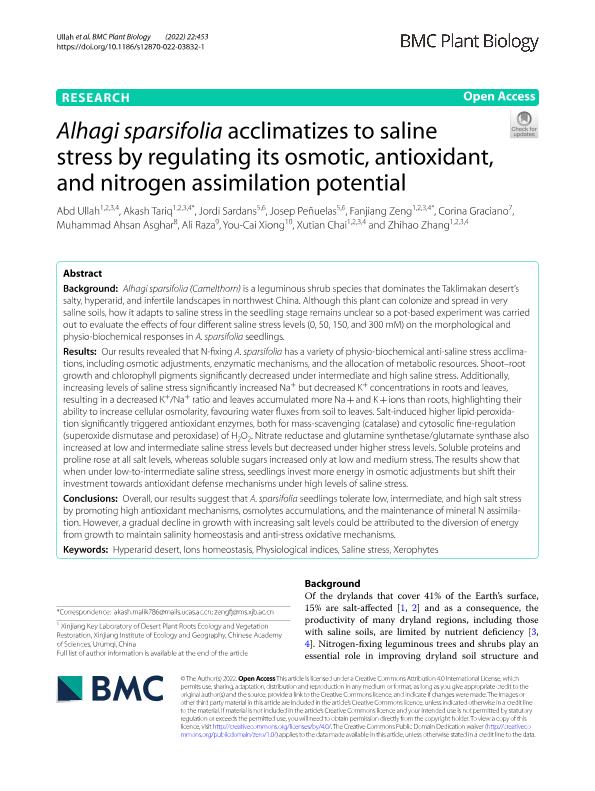Artículo
Alhagi sparsifolia acclimatizes to saline stress by regulating its osmotic, antioxidant, and nitrogen assimilation potential
Ullah, Abd; Tariq, Akash; Sardans, Jordi; Peñuelas, Josep; Zeng, Fanjiang; Graciano, Corina ; Asghar, Muhammad Ahsan; Raza, Ali; Xiong, You Cai; Chai, Xutian; Zhang, Zhihao
; Asghar, Muhammad Ahsan; Raza, Ali; Xiong, You Cai; Chai, Xutian; Zhang, Zhihao
 ; Asghar, Muhammad Ahsan; Raza, Ali; Xiong, You Cai; Chai, Xutian; Zhang, Zhihao
; Asghar, Muhammad Ahsan; Raza, Ali; Xiong, You Cai; Chai, Xutian; Zhang, Zhihao
Fecha de publicación:
12/2022
Editorial:
BioMed Central
Revista:
BMC Plant Biology
ISSN:
1471-2229
Idioma:
Inglés
Tipo de recurso:
Artículo publicado
Clasificación temática:
Resumen
Background: Alhagi sparsifolia (Camelthorn) is a leguminous shrub species that dominates the Taklimakan desert’s salty, hyperarid, and infertile landscapes in northwest China. Although this plant can colonize and spread in very saline soils, how it adapts to saline stress in the seedling stage remains unclear so a pot-based experiment was carried out to evaluate the effects of four different saline stress levels (0, 50, 150, and 300 mM) on the morphological and physio-biochemical responses in A. sparsifolia seedlings. Results: Our results revealed that N-fixing A. sparsifolia has a variety of physio-biochemical anti-saline stress acclimations, including osmotic adjustments, enzymatic mechanisms, and the allocation of metabolic resources. Shoot–root growth and chlorophyll pigments significantly decreased under intermediate and high saline stress. Additionally, increasing levels of saline stress significantly increased Na+ but decreased K+ concentrations in roots and leaves, resulting in a decreased K+/Na+ ratio and leaves accumulated more Na + and K + ions than roots, highlighting their ability to increase cellular osmolarity, favouring water fluxes from soil to leaves. Salt-induced higher lipid peroxidation significantly triggered antioxidant enzymes, both for mass-scavenging (catalase) and cytosolic fine-regulation (superoxide dismutase and peroxidase) of H2O2. Nitrate reductase and glutamine synthetase/glutamate synthase also increased at low and intermediate saline stress levels but decreased under higher stress levels. Soluble proteins and proline rose at all salt levels, whereas soluble sugars increased only at low and medium stress. The results show that when under low-to-intermediate saline stress, seedlings invest more energy in osmotic adjustments but shift their investment towards antioxidant defense mechanisms under high levels of saline stress. Conclusions: Overall, our results suggest that A. sparsifolia seedlings tolerate low, intermediate, and high salt stress by promoting high antioxidant mechanisms, osmolytes accumulations, and the maintenance of mineral N assimilation. However, a gradual decline in growth with increasing salt levels could be attributed to the diversion of energy from growth to maintain salinity homeostasis and anti-stress oxidative mechanisms.
Archivos asociados
Licencia
Identificadores
Colecciones
Articulos(INFIVE)
Articulos de INST.DE FISIOLOGIA VEGETAL
Articulos de INST.DE FISIOLOGIA VEGETAL
Citación
Ullah, Abd; Tariq, Akash; Sardans, Jordi; Peñuelas, Josep; Zeng, Fanjiang; et al.; Alhagi sparsifolia acclimatizes to saline stress by regulating its osmotic, antioxidant, and nitrogen assimilation potential; BioMed Central; BMC Plant Biology; 22; 1; 12-2022; 1-17
Compartir
Altmétricas



